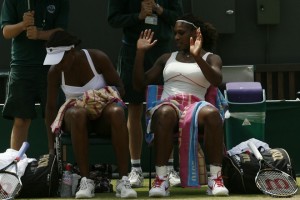I see a major publicity crisis, with its incumbent economic impact, on the horizon for women’s tennis and if, as I suspect, the Williams sisters are not far from declaring retirement, it could happen sooner than later.
The star-quality players of the WTA are disappearing and a great deal of the tour’s future depends heavily on how well WTA executives generate new stars whose appeal is more far-reaching than just their home countries.
Here’s what the WTA is facing:
Gone: Justine Henin, who declared after her relatively early defeat at the Australian Open, that she has retired a second time, and this time for good, with elbow damage.

Soon to be gone: Kim Clijsters, winner of the Aussie Open, who announced this is probably her last year and I think you can rightly assume that if she contracts a serious injury, meaning at least a month of down time, she could retire immediately.
And maybe gone: Serena and Venus Williams, who have played exactly one tournament since last year’s Wimbledon and only 15 tournaments combined (nine for Venus, six for Serena) since the 2010 Australian Open. If you need a benchmark here, the average number of tournaments over the last 52 weeks for the other eight top-10 players is 19.5.
I can’t tell you with certainty what the Williamses plans are. They live in a tightly controlled tennis environment where their injuries are never fully divulged to a public that supports their multi-million dollar lifestyles.
But after 17 journalistic years of hustling around professional tennis, my best hunch is that retirement announcements for one or both are not out of the realm of possibility this year.
Why? They don’t need the money. They’ve had their Grand Slam successes by the bunch. They have rather extensive lives outside of tennis, so this isn’t like Pete Sampras, who had little else to do but play golf five times a week when he quit.
And there is the inescapable facts about their injuries, whatever they may be. We may not know how Serena stepped on a piece of glass with a bare foot in a restaurant. Or how much damage it did. Or why she had a relapse during her training to get back on court. But we know both sisters have had injuries, chronically, and that those injuries have cut deeply into their time on court.
We’ve lost Henin and if we lose Clijsters and the Williamses, what’s left out there.
* Caroline Wozniacki. Suspect world No. 1 because she’s never won a major, but a very fine player. You can appreciate her talent if you’re a hard-core tennis fan, but she doesn’t have the game or the on-court personality to draft in television viewers who don’t normally watch tennis. Not in this country, anyway. Not like Serena and Venus. Not like Martina Navratilova or America’s sweetheart, Chris Evert.
* Vera Zvonareva. Solid top-5 player who now goes deep into every major draw. While Wozniacki gets a lot of internet time because of her looks, Zvonareva is under-publicized. Of the top players in the women’s game, she is the least known.
* Sam Stosur. Aussie living and training in Tampa, Fla. The main viewer attraction is the bulging biceps and the admirable high degree of fitness. You see her for the first time and you see a woman of average build who looks fantastic, physically.
* Francesca Schiavone. She got a faceful of red clay when she kissed the soil after winning the French Open. Good TV moment. But, other than that, she’s an unknown Italian.
* Jelena Jankovic. Great personality that comes out beautifully on the tube. Great sense of humor. But she’s not winning, so how often are you going to see her or hear her?
The TV ratings, for men and women, are in a plunge and, though I haven’t seen the numbers for the Clijsters-Li Na final, I wouldn’t expect anything significant, mainly because of the 16-hour time difference from the East Coast of the U.S. to Melbourne.
Women’s tennis was once heavyweight. The 1981 U.S. Open final between Tracy Austin and Martina Navratilova drew a 7.3. Williams vs. Williams in 2001 hit 6.8. And two years ago, when Clijsters beat Wozniacki in the U.S.Open final, a 1.1.
You can argue that the U.S. Open women’s finals have been hit hard by rain delays the last couple of years, but that’s a minor reason why ratings are down. At the U.S. Open, U.S. viewers want American players or at least players that attract their interest, and they’re not getting them often enough.
Of course, the United States isn’t the only country that watches or economically supports tennis, but this is the most lucrative tennis nation in the world — at least until China catches up.
Can the WTA “build” stars? Through the use of the internet and video, the WTA can always do a lot more to make “Wozniacki,” “Zvonareva,” and “Stosur” better known names in households where tennis isn’t but could be a priority sport for viewing.
I strongly suspect that stepped-up publicity for the top players isn’t going to be just something the WTA will want to do, even if the Williamses don’t retire, but it’s something it needs to do.
Women’s tennis went through a bad publicity patch when Martina Hingis was on top, during those non-descript years between the end of the Steffi Graf and the start of the Williams eras. The WTA has a fine product, but the electric personalities on which it has survived have either left the game or are soon to be gone. It’s time to get aggressive.
